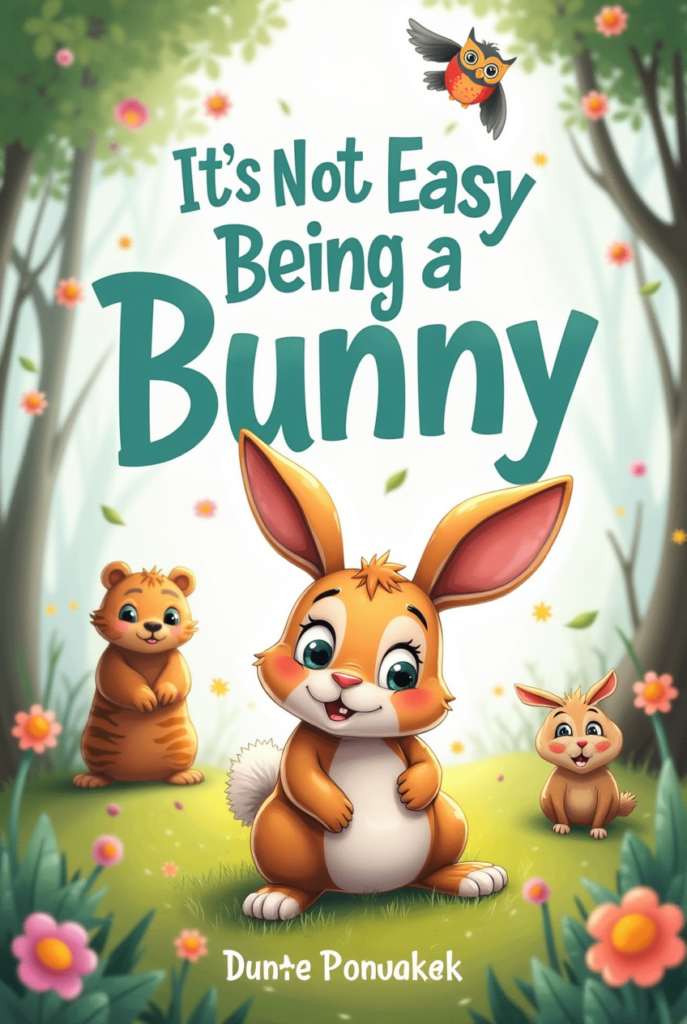Why It’s Not Easy Being a Bunny by Marilyn Sadler is a Heartwarming Tale for Kids and Parents Alike
When you think about children’s books, what comes to mind? Playful characters? Colorful illustrations? But beyond these elements, the best children’s books touch on universal themes—ones that resonate not just with kids, but also with parents. It’s Not Easy Being a Bunny by Marilyn Sadler does just that. This delightful story isn’t just a whimsical tale of a bunny; it’s a heartwarming exploration of what it means to grow, embrace one’s individuality, and navigate the ups and downs of life.

In a world where children face all sorts of pressures—whether at school or from the expectations of others—this book offers a gentle reminder that it’s okay to be yourself, even when things aren’t easy. As you turn the pages, you’ll find a relatable and comforting message that will resonate not only with kids but also with parents who are trying to raise emotionally intelligent, self-confident children. Here’s why It’s Not Easy Being a Bunny should be part of your child’s reading collection.
Table of Contents
What Makes It’s Not Easy Being a Bunny by Marilyn Sadler Special?
If you’re looking for a book that’s both fun and meaningful, then It’s Not Easy Being a Bunny should be at the top of your list. The story features a lovable bunny who faces challenges, just like anyone else. The book’s charm lies in its ability to highlight these challenges in a way that’s both relatable and lighthearted. Let’s explore what sets this book apart.
A Simple Yet Powerful Story
At its core, It’s Not Easy Being a Bunny is about a young bunny who is struggling with the typical challenges of growing up—finding out who they are and how to fit in. The bunny tries to be something they’re not, such as a bear, a tiger, or even an owl. Yet, in the end, the bunny realizes that being true to themselves is the best way to live.
The narrative is easy to follow, which makes it ideal for young readers who are just starting to explore the world of books. The straightforward storyline, combined with fun illustrations, draws kids into the world of the bunny and keeps them engaged from start to finish.
A Story for Both Kids and Parents
What sets this book apart is how it resonates not just with children but also with parents. The story serves as a conversation starter, encouraging parents to talk about the importance of self-acceptance, perseverance, and finding one’s own path. As you read along with your child, it’s an opportunity to reflect on your own journey of self-discovery, making the experience both personal and meaningful for both of you.
The Main Themes in It’s Not Easy Being a Bunny
Children’s literature often carries deep themes beneath its playful surface, and It’s Not Easy Being a Bunny is no exception. The following are some of the main themes explored in this delightful book that you’ll want to highlight with your child.
Self-Identity and Growth
A key theme in It’s Not Easy Being a Bunny is self-identity. The protagonist, a small bunny, initially believes they need to become something they’re not in order to fit in. Whether it’s pretending to be a bear or a tiger, the bunny is constantly trying to conform to someone else’s idea of what’s “better.”
This theme is incredibly powerful for children, especially when they’re in the early stages of figuring out who they are. As you read with your child, take a moment to talk about how the bunny’s journey of self-discovery can parallel their own. Everyone goes through phases of self-doubt and change, and it’s important for kids to understand that these feelings are a natural part of growing up.
Overcoming Challenges and Embracing Differences
Another important lesson in It’s Not Easy Being a Bunny is about overcoming challenges and embracing differences. The bunny tries hard to be something they’re not, which leads to frustration and disappointment. But ultimately, the bunny learns that being true to oneself is the best way to find happiness.
For children, this message is key. They’ll see that even when things don’t go as planned, they can still find their own way. The book encourages them to accept their own uniqueness rather than trying to live up to the expectations of others. This theme fosters resilience, which is a critical skill for emotional development.
Why It’s Not Easy Being a Bunny is Perfect for Early Readers
When choosing books for young readers, it’s important to find ones that engage them both intellectually and emotionally. It’s Not Easy Being a Bunny excels in this area, making it a great option for early readers. Let’s explore why it’s such a fantastic choice for children aged 3-7 years.
Simple Language and Repetition
For young readers, language matters. One of the key features that make It’s Not Easy Being a Bunny perfect for early readers is its simple language. The book uses straightforward sentences and a repetitive structure, which not only keeps the story engaging but also helps children build their vocabulary.
Repetition plays a significant role in helping kids recognize words and sentence structures, making reading easier and more enjoyable. This is especially important for children who are just beginning to develop their reading skills.
Illustrations and Visual Storytelling
As much as the words matter, the illustrations in It’s Not Easy Being a Bunny are just as important. The book is filled with vibrant, colorful illustrations that not only bring the bunny’s world to life but also visually convey the emotions the bunny is experiencing.
The illustrations serve as an excellent tool for helping children understand the story’s emotions. For example, when the bunny is frustrated, the illustrations show exaggerated facial expressions and body language, making it easier for kids to relate. This visual storytelling helps strengthen the connection between words and emotions, enhancing the reading experience.
Parent and Educator Insights: How It’s Not Easy Being a Bunny Helps Foster Emotional Intelligence
In addition to being a fun and engaging read, It’s Not Easy Being a Bunny also offers valuable lessons in emotional intelligence. As a parent or educator, you can use this book as a tool to help children better understand and manage their emotions.
Understanding Emotions
Throughout the story, the bunny experiences a wide range of emotions—from frustration and disappointment to joy and acceptance. These emotional ups and downs provide the perfect opportunity to talk with your child about how they might feel in similar situations. You can ask them how they think the bunny felt when trying to be something they weren’t or what they would do if they were in the bunny’s shoes.
By using this book as a starting point for discussing emotions, you’re helping your child develop emotional awareness, which is an essential skill for building empathy and resilience.
Building Empathy and Compassion
Another important lesson in the book is empathy. As the bunny learns to embrace who they are, they also begin to understand and accept the differences in others. This is a powerful message for young readers, teaching them that everyone has their own unique qualities and challenges.
For parents and educators, this theme offers a great way to encourage children to think about how others might feel. You can use the book to prompt discussions about kindness, understanding, and how to treat others with respect.
Teaching Valuable Life Lessons with It’s Not Easy Being a Bunny
Every great children’s book teaches lessons that go beyond the page. It’s Not Easy Being a Bunny is no exception. Here are a few important life lessons that this book can help you impart to your child.
The Power of Trying Your Best
One of the most important lessons from the book is the value of trying your best, even when things are tough. The bunny faces numerous obstacles in trying to be something they’re not, but through perseverance, they eventually find happiness. This teaches children that failure is part of the process and that they should never give up.
Learning from Mistakes
The book also shows that mistakes aren’t the end of the world—they’re opportunities for growth. The bunny’s journey teaches children that it’s okay to make mistakes and that learning from them is an important part of becoming who they’re meant to be.
Summary of Key Lessons in It’s Not Easy Being a Bunny
| Lesson | Description | How to Apply |
|---|---|---|
| Embracing Individuality | Understanding that being yourself is a beautiful thing. | Encourage your child to talk about what makes them unique. |
| Perseverance | The importance of not giving up, even when things get tough. | Share personal stories of challenges you’ve overcome. |
| Learning from Mistakes | Mistakes are an opportunity for growth. | Emphasize the value of trying again after a mistake. |
| Empathy | Developing an understanding of others’ feelings. | Teach children to consider how others might feel. |
FAQs About It’s Not Easy Being a Bunny by Marilyn Sadler
Q1: What age group is It’s Not Easy Being a Bunny suitable for?
A1: It’s Not Easy Being a Bunny is perfect for children aged 3 to 7 years old. The story’s language is simple, and the themes are easy for young readers to understand.
Q2: What lessons can children learn from It’s Not Easy Being a Bunny?
A2: Children can learn important lessons about embracing their individuality, perseverance, and understanding emotions.
Q3: Can parents use It’s Not Easy Being a Bunny to teach their children about empathy?
A3: Yes! The book provides a great opportunity to talk about empathy and how understanding others’ feelings is an essential part of making friends and being kind.
Q4: Is It’s Not Easy Being a Bunny a good read-aloud book for families?
A4: Absolutely! Its charming story and vibrant illustrations make it a great choice for family read-aloud sessions.
Conclusion: Why It’s Not Easy Being a Bunny is a Must-Read for Children
Whether you’re reading aloud with your child or encouraging them to explore it on their own, It’s Not Easy Being a Bunny is a story that offers more than just entertainment. It provides valuable life lessons about growth, perseverance, and the importance of being true to yourself. If you haven’t yet added this heartwarming book to your library, now is the perfect time. Let it inspire conversations and reflections, and help your child navigate the complexities of growing up with confidence and empathy. Grab a copy today and start the journey with the bunny!

